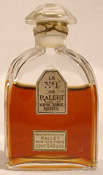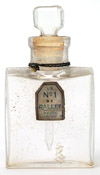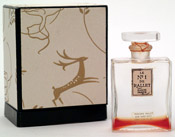Lightyears Collection
Le No.1
1913/1923
Rallet
|
In the year 1912, Robert Bienaimé, an up and coming perfumer who would someday launch his own perfume company, witnessed the launch of his masterpiece, Quelques Fleurs, by Houbigant. In the same year, Ernest Beaux's Bouquet de Napoleon was taking Russia by storm.
In 1912, Paris was a favorite shopping and entertainment destination for wealthy Russians. Since the 19th century, the Nord Express had run twice weekly from St. Petersburg to Paris. Many members of the Imperial family had their own rail cars.
Ernest Beaux was well aware of innovations in perfumery taking place in his father's native land. Moreover, his own employer, A. Rallet & Co, had been owned since 1898 by the firm of Antoine Chiris of Grasse.
Bouquet de Napoleon, for all its success, was not on the cutting edge of modern perfumery. Bienaimé, in Quelques Fleurs, had made use of aldehyde C-12 MNA and Bienaime's successful use of this new odorant (available since about 1903) piqued Beaux's interest.
In 1913, to celebrate the tercentenary of the Romanov dynasty, A. Rallet & Co launched Bouquet of Catherine, Beaux's first known fragrance to make use of aldehydes. But unlike Bouquet de Napoleon, Bouquet de Catherine failed to achieve commercial success and the following year, when war broke out in Europe, Beaux reported for duty with the French army. While many expected the war to be over by Christmas, in fact Beaux remained in military service until 1919.
Bouquet of Catherine was, by 1923, reborn as Rallet Le No.1. We do not know at what point this renaming occurred or whether it took place in Russia between 1913 and 1917 in Beaux's absence or in France after 1917, where Rallet's French staff had taken refuge from the Bolshevik revolution. In any event, upon Beaux's return to Rallet — in France — he began the experiments which ultimately resulted in a series of perfumes including those he gave to Gabrielle Chanel.
Today, Bouquet de Catherine, in it's Rallet Le No.1 rebirth, can be seen as the predecessor of Chanel No.5. The overall concept of Rallet Le No.1 is followed in Chanel No.5 — the use of a "cocktail" of aldehydes — to overcome the fatty note of the jasmine absolute and rose oil. It was this fatty note that had plagued perfumery in the 19th century when all perfumes had the unwanted fatty note but this had simply been accepted as it could not be overcome. While Rallet Le No.1 stands on its own merit as a fragrance, its role in the development of Chanel No.5 gives it a special place in the history of 20th century perfumery.
But why is Chanel No.5 remembered and still marketed today while Rallet Le No.1 had long since disappeared? Much has to do with the marketing history of the two fragrances. Prior to 1917, Rallet was a very large, very profitable enterprise. But its market was the aristocracy and wealthy merchant class of Imperial Russia. The 1917 Bolshevik revolution swept both away. Those who escaped the Bolshevik terror, for the most part escaped with only their precious gems, the sudden forced sale of which — by so many emigrées simultaneously, greatly depressed the gem market — and the wealth of formerly wealthy Russians. Russians who prized Rallet products could no longer afford them.
|
Rallet — formerly with 1600 employees in its Moscow factory alone, with factories, plantations and retail outlets throughout Russia — saw all of this lost. The company, now greatly reduced in capital and influence, nopw had to compete with well established French perfumeries while their administration was in disarray and Beaux, their technical director, still off at war.
It has been suggested that Ernest Beaux, upon returning to France, tried to sell the Rallet Le No.1 to François Coty. Coty had a close relationship with Leon Chiris, who had allowed Coty to attend Chris's perfumery school at a time when Coty was a complete unknown. Moreover, Rallet had distributed Coty's fragrances in Russia before Coty had set up his own Russian distribution. But Rallet Le No.1 was a more expensive fragrance than Coty wished to undertake in 1919, a time when Coty's fortune was being built on selling small bottles of high quality fragrances to "shopgirls" — lots and lots of shopgirls. Ironically, after Beaux left Rallet to go with Chanel and the Wertheimers, Coty stepped in and bought Rallet itself.
|
Meanwhile, Beaux was introduced to Gabrielle "Coco" Chanel by another refugee from Russia — Grand Duke Dimitri Pavlovitch. This introduction let to the creation of Chanel's No.5 (first offered in 1921), the creation of Parfums Chanel (1924), and Beaux's employment by Parfums Chanel and Bourjois (1924) which would last until a few months before his death in 1961. It would now be Chanel and Bourjois that would release Beaux's fragrances to the world and support them with an excellent marketing program.
In the spring of 2007, a research team led by Dr. Philip Kraft, Givaudan SA, undertook to analyze and reconstruct the formula for Rallet Le No. 1. The results of this study were published in "From Rallet No.1 to Chanel No.5 versus Mademoiselle Chanel No.1" in the October 2007 issue of Perfumer & Flavorist. (Reprints are available from the publisher.) Not only did this work reveal the relationship between Rallet Le No.1 and Chanel No.5, it also uncovered an unexpected relationship between Rallet Le No.1 and Mademoiselle Chanel No.1, a fragrance offered by Gabrielle Chanel in the 1940's — in violation of her contract with Parfums Chanel.
In France, it appears that Rallet Le No.1 was first marketed around 1923. When Coty bought Rallet in 1926, he promoted Rallet as a luxury brand and Rallet Le No.1 appeared, in typical Coty fashion, in identical bottles of several sizes from about 1929 to about 1935.
Rallet Le No.1 lingered for a number of years but eventually disappeared from the market. No other Rallet, post-1917 fragrance, achieved even the modest commercial success achieved by Le No.1.
If you have any information on Rallet or Rallet's Le No.1 that you would like to share with us, please do so using the message sender below.
|


Philip Goutell
Lightyears, Inc.




